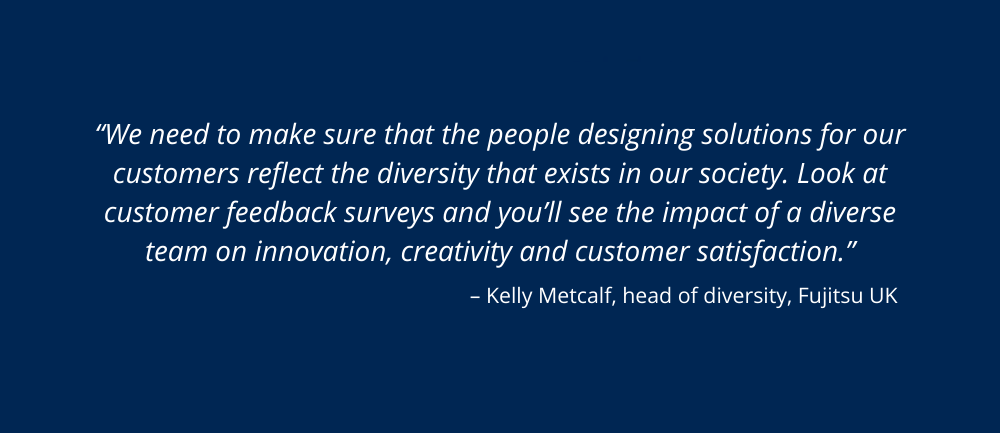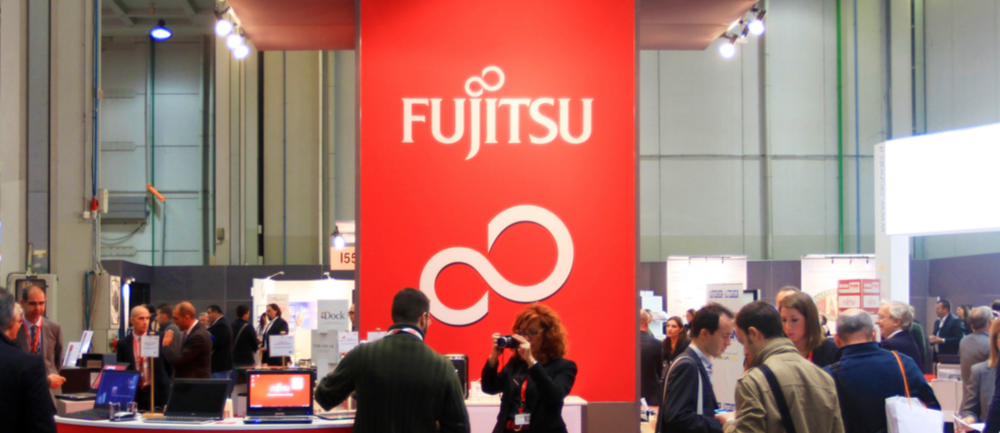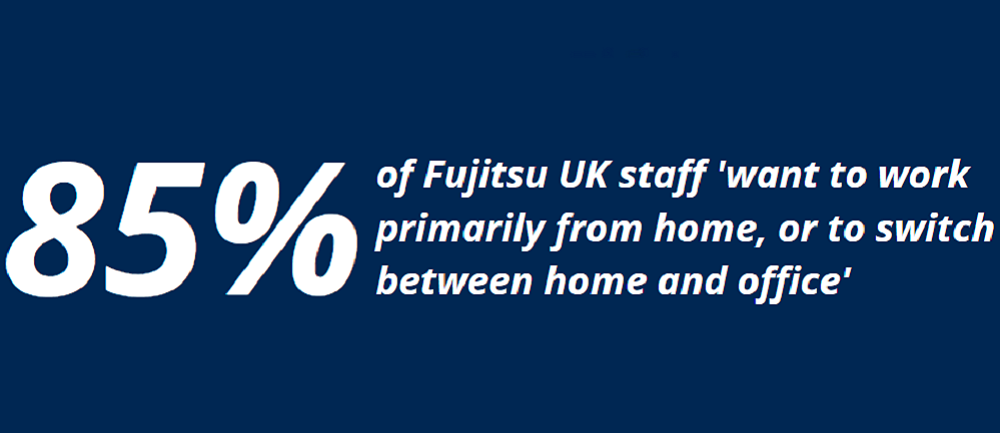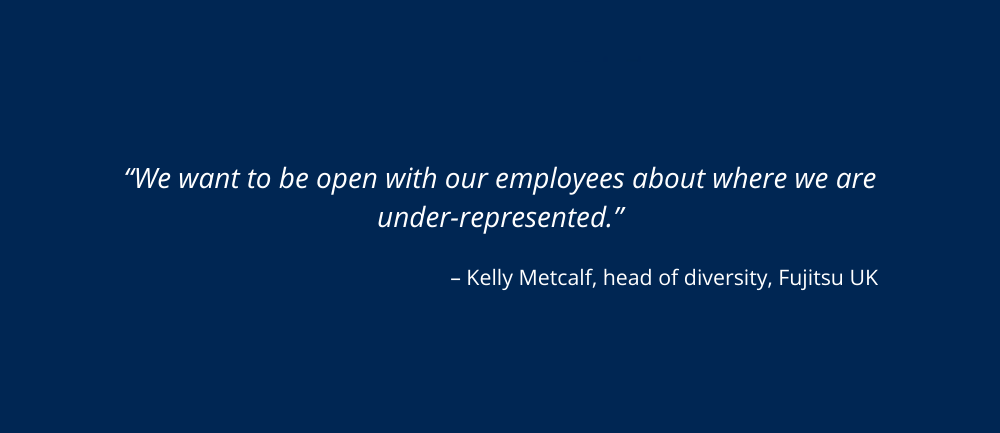-
Provided by

- Date published: Jul 15, 2021
- Categories
Fujitsu is one of the world’s biggest IT services providers and in February was named on Fortune’s list of the World’s Most Admired Companies for the third year in a row. The UK division has continued to thrive during the pandemic, picking up a string of high-profile contracts.
However the company, which was founded in 1935, is striving to use the pandemic as a catalyst for diversity. Like many businesses in the tech space, Fujitsu remains a predominantly male workforce, but work is continuing apace to change that.
Kelly Metcalf, Fujitsu UK’s head of diversity, inclusion and wellbeing, explains how the British arm of the company is leading this campaign – and how digital technology is at the forefront of the project.
The state of talent acquisition
Whenever Fujitsu UK goes to the job market, the recruitment team is now required to use a standard template for their advert. The template sets a universal baseline for inclusion, ruling out any discriminatory words and phrases from the get-go. And what’s really interesting is the technology it is based on.
Fujitsu’s template was built using Textio, a piece of machine learning software which draws on millions of recruiting outcomes from around the world. This huge data set is channelled into a predictive model which recognises words that may discourage women and minorities.
The application of machine learning is just part of a multi-pronged diversity drive spearheaded by Kelly Metcalf, who has been with Fujitsu 14 years in a variety of HR roles. Now she is charged with freshening up Fujitsu’s workforce and creating a talent-management process that reflects the company’s flagship commitment to digital transformation.
“If we’re going to be an innovative technology partner for our customers,” Kelly says, “we need to make sure that the people designing solutions for our customers reflect the diversity that exists in our society. Look at customer feedback surveys telling us they expect fresh ideas. This innovation and creativity is what diverse teams bring.”
__
There is definitely work to be done on this front. In the UK, the average Fujitsu employee is in their early-40s. While this is no more than the overall national average, it is significantly higher than the figure for the digital tech industry, which is around 35. The gender demographic is even more pressing; around 24 percent of Fujitsu’s workforce is female, which compares to 44 percent across all high-skilled UK occupations.
The effects of Covid

Fujitsu is a company born and raised in Japan, a country which has historically been known for its demanding, office-based working culture. This heritage may go some way to explaining the predominance of mature male workers.
However, the pandemic has already transformed Fujitu’s working practices. Its leadership team has stated a commitment to what it terms ‘the work-life shift’: an employee now has the right to pursue a working arrangement that maximises their productivity. Individual countries have also made their own arrangements.
In the UK, Kelly has been instrumental in creating a new, hybrid working model. She and her team have created new guidelines around the purpose of the office: employees have been encouraged to think about why they want to come into work and have a clear purpose whenever they visit.
“We started to survey people from April last year to understand how they were finding Covid, their priorities, what support they needed etc,” Kelly says. “We’ve carried on that theme ever since, working with trade union reps and people leaders and organising focus groups that any employee can join, to help define our future way of working.

“In September last year we asked all our employees to tell us how they want to work when these restrictions end. Eighty-five percent told us they either want to work primarily from home or they want to flex between home and office. Only 9 percent wanted to be full-time office-based.
“The culmination is that, for the UK, we’ve made a commitment that in the future, you can agree on the right pattern of work locations with your manager to balance both your customer commitments and personal preferences.”
Now the agreement is in place, Kelly believes it can encourage a broader talent pool.
“There’s a stat that says ‘if a job advert mentions flexible working, it will attract 26 percent more female candidates’ and I certainly feel that the way we’ve changed through Covid can be a catalyst for diversity, particularly in more senior roles where previously someone might have held themselves back because of working hours or travel requirements.
“We’re taking away some of those hurdles which may previously have seemed insurmountable.”
However, to reap the benefits of this cultural shift, Kelly and her team need to realise two principal objectives. On one hand they need to create the best possible environment for diversity to flourish; on the other, they need to open themselves up to the widest possible talent pool.
Providing a voice
To pursue the first objective, Kelly and her team operate a series of separate employee networks. In addition to two global diversity and inclusion networks, run at a global level, Fujitsu UK has employee-led networks entitled Women’s Business, Cultural Diversity, Ability Matters, Fujitsu Pride and Next Generation, which specifically reaches out to younger workers. Around 1,500 UK workers have signed up to at least one of these networks – nearly a quarter of the entire total.
“The networks give a voice to our employees,” Kelly says. “They’re all employee-led, but each one is sponsored by one of our UK executive teams to make sure there is that senior voice at the table. It’s not only about bringing employee perspectives together but also making sure those voices are being heard.
“They also provide activities, which have been hugely important during Covid-19. Our Pride network does weekly coffee chats where people can come together in virtual breakout rooms to meet people, not in a contrived way but in a way that you might bump into people in the office restaurant. We’ve also done virtual dance classes to teach Bollywood, which have been held during home-schooling so people can get their kids involved… there are all kinds of ways people are being brought together.”
These networks are backed up by feedback from Fujitsu’s bi-annual engagement survey, which enables leaders to understand the different experiences of each individual group.
As an example, Kelly cites the particularly positive sentiment expressed by female respondents towards flexible working, “which has helped to reinforce our clear commitment to sustaining more flexible and hybrid working beyond the pandemic.” She also highlights the less favourable feedback provided by trans colleagues in Fujitsu’s December 2020 survey, which prompted the people leaders to organise a roundtable specifically for trans people. In the wake of this roundtable, Fujitsu UK held an audit to ensure gender-neutral language in all policies and systems and organised further education around the issue of trans allyship.

Talent strategy: a fresh focus
In parallel with these efforts to engage the existing workforce, Fujitsu UK’s leadership team is pouring huge amounts of time and effort into retooling their recruitment operation for the next generation.
“There’s a big focus on junior-level recruitment, particularly the apprenticeship and graduate scheme, and we aim to take a really broad approach,” Kelly says. “When we’re recruiting from universities we don’t just approach the Russell Group, we look way beyond that.”
Although many companies have embraced blind CVs, Fujitsu has yet to pursue this idea. Instead, they strive to provide diversified candidate shortlists. However, as Kelly explains, this doesn’t involve fixed targets.
“We used to say we expect a shortlist with 50 percent women but that’s not always realistic in certain job roles. The target actually started to impact the quality of candidates, because it became something of a numbers game for our recruitment partners. So we’ve relaxed that a little bit and as a result, we now see a higher conversion rate of female candidates to successful offer.
“From a gender point of view, we simply say we want a balanced shortlist, with one or two candidates from the under-represented side. That works both ways – some parts of our workforce are very female-dominated.”
Then, there’s the technology.
As well as Textio, the recruitment team make use of two further screening tools, provided by recruitment software firm Eploy and developer Kat Matfield, who built her own ‘gender decoder’ as a personal project. These tools provide a last check, just to be sure nothing discriminatory has slipped through.
“Language can be discriminatory in ways you wouldn’t think,” Kelly says. “You could write ‘we’re looking for an ambitious and driven developer,’ but that elicits slightly different responses from women and men, because ‘driven’ is seen as more of a male descriptor, going back to childhood.
“Then there’s stuff about needing ‘X years’ experience’. Do we really need that? Or actually, do we need someone with this particular attitude and mindset, curiosity and aptitudes to take on new responsibilities? Simply saying the same role in a different way can make it more inclusive.”
In each advert, the writers strive to highlight the company’s commitment to diversity, inclusion and flexible working, based on location and working hours. Simply by flagging Fujitsu’s positive strides, Kelly believes “we can progress diversity in more senior roles where maybe someone may have held themselves back.”

Results to date
Fujitsu UK has onboarded around 200 new starters over the past 12 months, and there are signs that the diversity initiatives are starting to bear fruit.
Kelly points out that the executive team now has a 50/50 gender split, and the pay gap has come down from 17.9 percent in 2017 to 11.6 percent in 2020. Fujitsu was among the first UK organisations to publish its gender pay data at a national level, and there are now plans to publish its ethnicity pay gap, even though there is no formal requirement to do so. “We want to be open with our employees about where we are under-represented,” Kelly says.
The company’s progress has been reflected in a raft of awards. Fujitsu UK has been accredited among the Times Top 50 employers for women for the past four years, and is recognised as both a Disability Confident Leader and a top employer by the Social Mobility Foundation. The business also features in the Stonewall Workplace Equality Index and has been a case study in the previous 2 BITC Race at Work Reports.
Going forward, Kelly believes further change will come gradually. The company already has targets around gender diversity and is in the process of setting goals for ethnic diversity, although she is wary of making these targets public for fear of causing division.
Long-term, the goal remains the same: to provide a company which is as innovative internally as it is externally. Machine learning job ads are just the start.

